Physical Address
304 North Cardinal St.
Dorchester Center, MA 02124
Neurogenous tumors arising within bone are exceedingly rare. Neural lesions frequently exert secondary effects on bones, eroding them from the surface and deforming and expanding neural canals and foramina because of the pressure of expansile growth, as in the case of neurofibromatosis. On the other hand, some of the most common tumors of the central nervous system, namely meningiomas and ependymomas, have a tendency to invade bone and may provoke striking reactive changes in affected bone that mimic primary bone neoplasms. The rarest of primary neural tumors arising in bone are the neurilemmomas (schwannomas) and malignant peripheral nerve sheath tumors. Neurofibromatosis, separated into three distinct clinical syndromes referred to as types 1 through 3, is primarily a disorder of the soft tissues, but it can affect many other organs and the skeleton. Von Hippel-Lindau disease and its hallmark tumor, hemangioblastoma, is also included in this chapter, with the discussion focusing on the skeletal manifestations of the disease with the development of a unique papillary endolymphatic sac tumor involving the petrous portion of the temporal bone.
Meningiomas are not generally considered to be neural tumors of bone, but they are in fact the most common tumors of the central nervous system to erode bone. Meningiomas are common neoplasms that originate from meningothelial cells. Although meningiomas may invade the brain, they most often affect the central nervous system structures by a pushing, expansile growth rather than by invasion. On the other hand, meningiomas have a unique propensity to involve the contiguous bone and may mimic a primary bone tumor. Involvement of bone is not indicative of malignant behavior per se. Meningiomas may alter adjacent bones by direct invasion or may cause a hyperostotic reaction. In the latter case, there is no true invasion of bone. This neoplasm provokes bone overgrowth of periosteal origin, usually from the inner table of the cranial bones.
Most meningiomas become clinically evident in patients older than age 40 years and are rare in children. Meningiomas occur more frequently in women. The male-to-female ratio is 2 : 3 for intracranial lesions; for intraspinal meningiomas, the male-to-female ratio is 1 : 10.
Meningiomas are slow-growing lesions, but their indolent growth rate is increased during pregnancy. This is partially explained by the presence of steroid receptors in these tumors. Theoretically, meningiomas can develop anywhere in the meninges; however, they appear frequently in certain anatomic sites. The parasagittal area is the most frequent location for cranial meningiomas. Other common locations include the lateral aspects of the cranial vault (over the cerebral convexities), the wing of sphenoid bone (sphenoid ridge meningioma), the sella turcica area (suprasellar meningioma), the cribriform plate (olfactory groove meningioma), and the area of the foramen magnum and the optic nerve. In addition to the common locations within the central nervous system, meningiomas can present as extracranial lesions in many sites. The soft tissues of the head and neck are the most frequent sites of involvement external to the central nervous system. Rare examples of meningiomas in the lung, the mediastinum, and even the fingers have been described. We have seen in consultation two examples of apparently primary meningiomas involving the pubic ramus. Skull lesions may have the same or similar radiographic features as metastatic carcinoma or, less frequently, hemangioma or osteosarcoma.
Meningiomas usually occur sporadically but it is estimated that approximately 5% are familial and fewer than 10% of individuals have multiple lesions. The environmental risk factors, except for radiation, are uncertain. An increased risk for the development of meningiomas has been associated with several tumor susceptibility syndromes such as neurofibromatosis type 2, Cowden syndrome, and Werner syndrome. These syndromes have unique genetic backgrounds and are caused by mutations in the NF2, PTEN, and RECQL2 genes, respectively. The mutations of the tumor suppressor gene NF2 are present in more than 70% of meningiomas developing in individuals affected by neurofibromatosis type 2. The loss of the wild type NF2 allele is present in almost all meningiomas associated with neurofibromatosis type 2. The somatic mutations of the NF2 gene are also present in the majority of sporadic meningiomas not associated with neurofibromatosis type 2. Sporadic meningiomas appear to have unique genetic alterations that are exclusive of the NF2 gene mutations. A recent genomic analysis of meningiomas has identified that sporadic meningiomas not associated with neurofibromatosis type 2 are characterized by mutations in TRAF7, a proapoptotic E3 ubiquitin ligase, in approximately 25% of tumors ( Fig. 14-1 ). These mutations are concurrent with the mutations in KLF4, a transcription factor inducing pluripotency, or AKT1 activating the PI3K pathway and SMO mutations that activate Hedgehog signaling ( Fig. 14-1 ). Extremely rare cases of familial meningiomas without neurofibromatosis type 2 were shown to be associated with mutations involving the SWI/SNF chromatin-remodeling complex subunit genes SMARCE1 or SMARCB1 . Loss of SUFU, suppressor of fused homolog of Drosophila, dysregulating Hedgehog signaling was also identified in some families affected by multiple meningiomas ( Fig. 14-2 ).
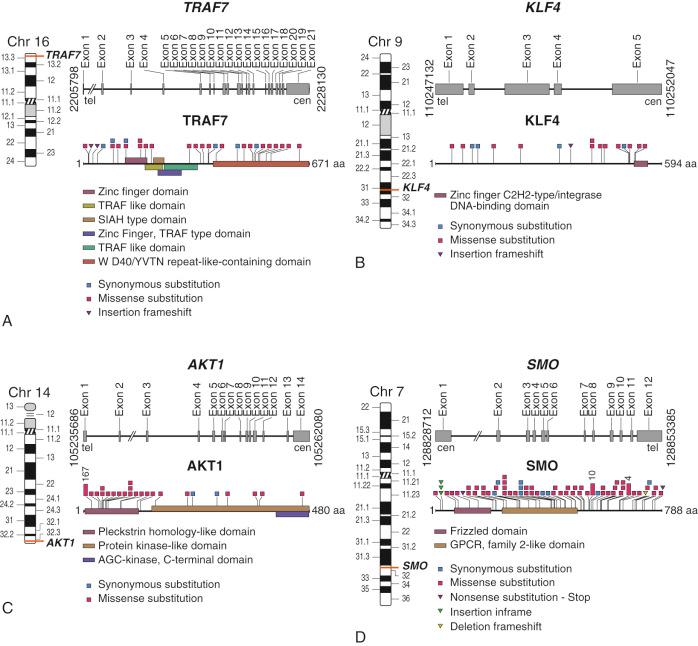
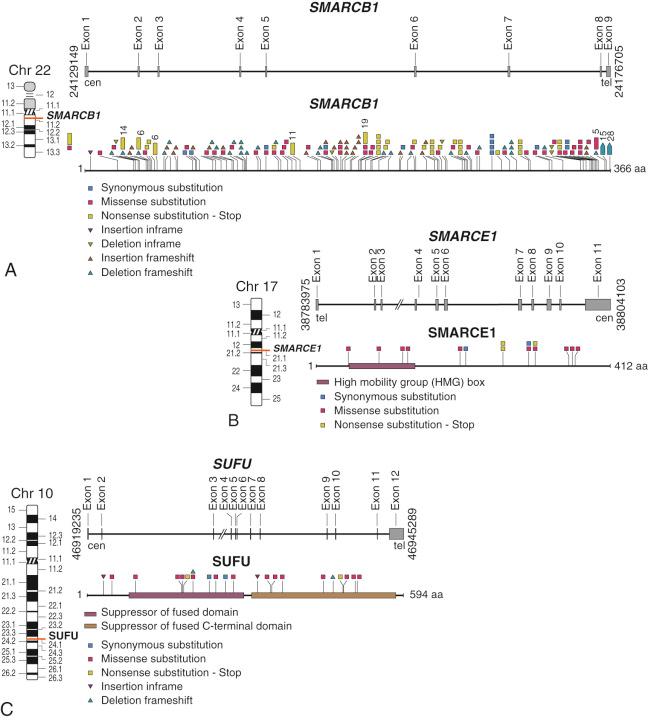
The classic radiologic presentation of meningioma is that of a homogeneously contrast enhancing dura-based mass with small peripheral extensions referred to as the dural tail ( Fig. 14-3 ). Other radiographic presentations include a flattened extensive lesion referred to as en plaque meningioma or an intraventricular (choroid plexus) meningioma. In addition, classic presentation is as a very large anterior cranial fossa mass centered in the midline (olfactory groove meningioma) ( Fig. 14-3 ). Meningioma may also present as a purely intraosseous tumor. In such instances, it may be mistaken for a different type of primary bone lesion; for example, intraosseous meningioma of the sphenoid bone may be mistaken for fibrous dysplasia. In addition, some histologic subtypes of meningioma may contribute to misdiagnosis; for example, intraosseous secretory meningioma may be mistaken for metastatic carcinoma ( Fig. 14-4 ).
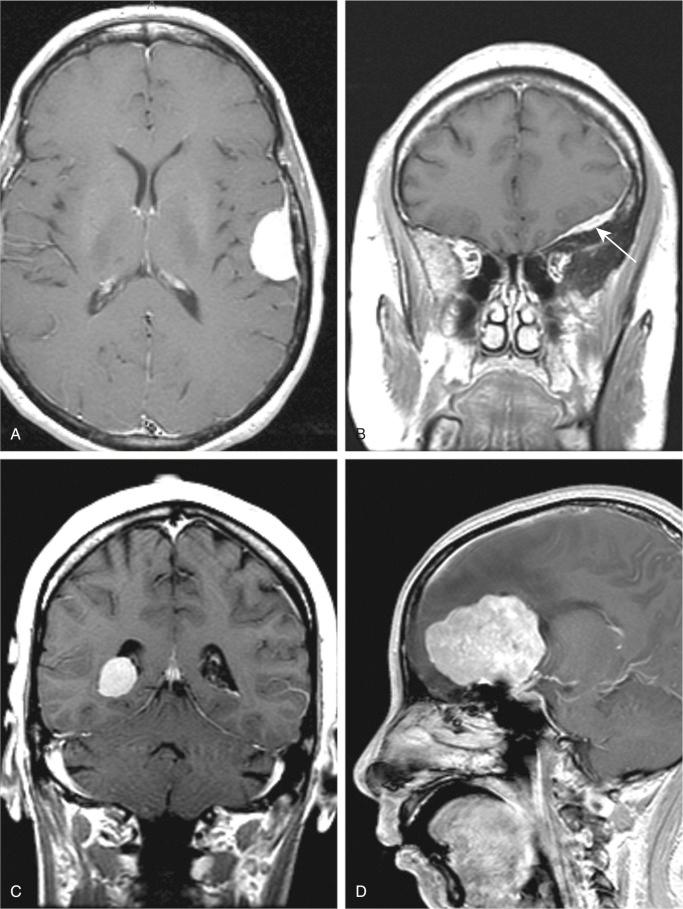
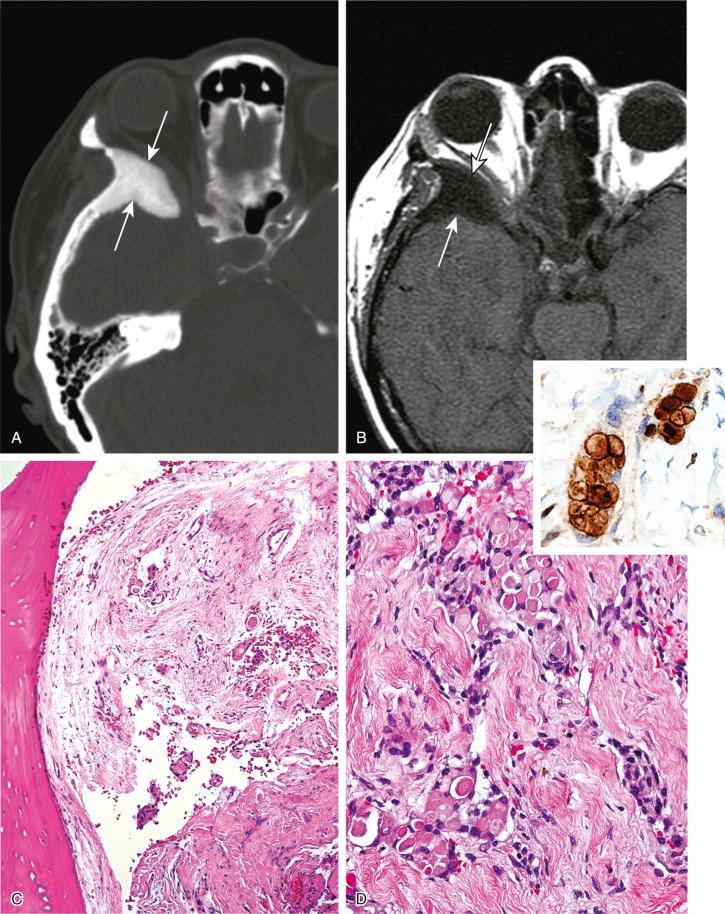
Some meningiomas show involvement of three anatomic compartments: cranial bone, intracranial extension, and extracranial extension into the scalp ( Fig. 14-5 ). Often, meningiomas induce prominent periosteal new bone formation in the form of perpendicular striations that radiate from the lesion on the inner and outer surfaces of the affected bone ( Fig. 14-6 ). Meningiomas must therefore be differentiated radiographically from other primary and metastatic bone lesions. Higher grade meningiomas frequently exhibit atypical radiographic features as well, including a blurred or diffuse interface with the subjacent brain parenchyma, or a multilobulated appearance (mushroom sign). In addition, brain invasive meningiomas are often accompanied by marked brain edema ( Fig. 14-7 ).
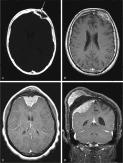
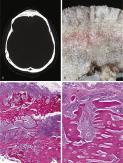
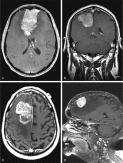
Microscopically, meningiomas represent a group of neoplasms with various heterogenous features linked by focal similarities to normal meningothelial cells ( Table 14-1 ). The nuclei are round or oval with small nucleoli and fine, evenly dispersed chromatin. Intranuclear inclusions are frequently present. The four classic histologic subtypes of meningioma are syncytial, fibroblastic, transitional, and psammomatous ( Fig. 14-8 ).
| Type | Microscopic Features |
|---|---|
| WHO Grade I | |
| Meningothelial (syncytial) | Syncytium-like histology (cell borders are not easily discernible). |
| Fibroblastic (fibrous) | Compact fascicles of highly spindled cells (fibroblast-like) alternating with areas of syncytial appearance, giving an alternating “on-edge” and “en face” feeling. Some tumors have prominent collagen bands, which may calcify in a linear, spiculated fashion (distinct from spherical psammoma bodies). |
| Transitional | A swirling together of the syncytial and fibroblastic patterns, with resultant prominent cell whorls that constitute the hallmark feature of this subtype. The whorls may calcify, beginning in the center, creating a psammoma body. |
| Psammomatous | Essentially a transitional meningioma in which a large percentage of the meningothelial cell whorls have calcified (formed psammoma bodies). There is no specified number, percentage, or density of psammoma bodies that is required to “qualify” as a psammomatous meningioma. |
| Angiomatous | Meningioma in which the vasculature is especially dense and prominent. Frequently shows degenerative nuclear atypia. An older term, angioblastic , is inaccurate and obsolete. |
| Metaplastic | Displays focal areas of bone, cartilage of fatty metaplasia. As with the other grade I meningioma subtypes, there is no prognostic significance. |
| Secretory | The hallmark morphologic feature is the presence of pseudopsammoma bodies, which are brightly eosinophilic intracystoplasmic globular inclusions (proteinaceous secretions) of varying number and size. Pseudopsammoma bodies are strongly positive for carcinoembryonic antigen, and the cells that produce them are strongly positive for epithelial membrane antigen and keratin. |
| Lymphoplasmacyte-rich | Among the rarest of meningioma subtypes, this exhibits prominent collections of chronic inflammatory cells (lymphocytes and plasma cells). |
| Microcystic | Characterized by prominent microcystic architecture throughout the tumor; may not otherwise bear much resemblance to traditional meningioma morphology. Frequently displays prominent, often hyalinized, vasculature and degenerative atypia, thus overlapping with the angiomatous subtype. |
| WHO Grade II | |
| Chordoid | Cords of tumor cells separated by myxoid matrix. |
| Clear cell | Cytoplasmic clearing in a majority of tumor cells can obscure the meningothelial nature of the tumor; whorls can often be highlighted by immunostaining for vimentin or epithelial membrane antigen. |
| WHO Grade III | |
| Rhabdoid | Rhabdoid morphology (small epithelioid cells with globular eosinophilic cytoplasm and eccentric nuclei) predominates in this variant, which, like the microcystic subtype, may not be instantly recognizable as meningothelial in origin by those not familiar with the entity. Mitotic activity is typically elevated. |
| Papillary | Tumor cells form perivascular pseudorosettes (similar to those seen in ependymoma), which may artifactually dehisce, giving a papillary (pseudopapillary) appearance. As with the rhabdoid subtype, mitotic activity is usually elevated. |
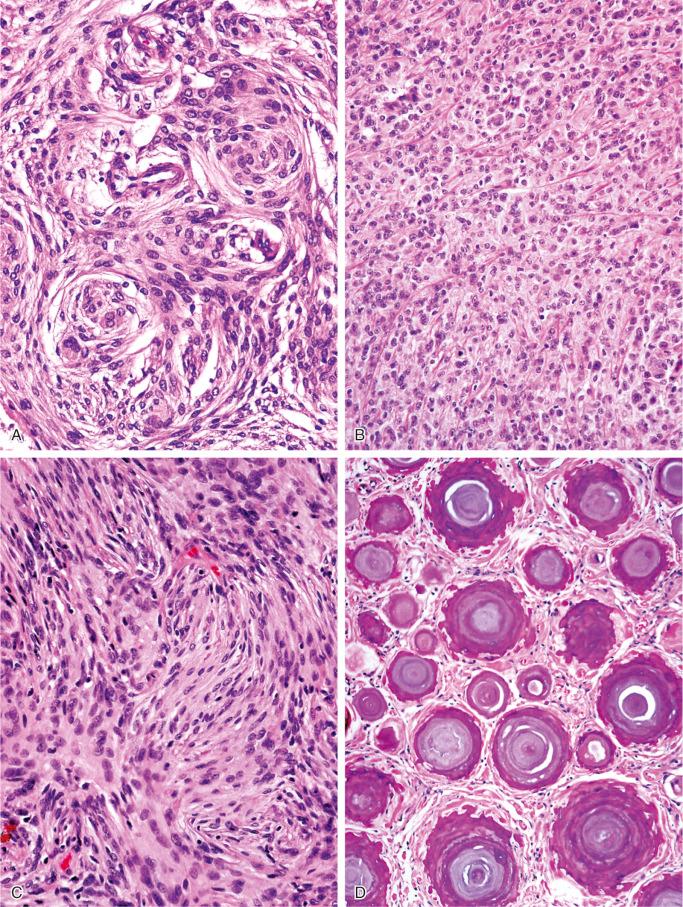
Syncytial meningioma is characterized by patternless architecture, without other distinctive features. The lack of a distinct cytoplasmic border (i.e., the syncytial appearance of meningothelial cells) is explained at the ultrastructural level by the complex interdigitating cytoplasmic processes.
Fibroblastic or spindle-cell meningioma is characterized by the presence of elongated spindle cells arranged in fascicles with a focal storiform pattern. Focal syncytial features with a whorled pattern and psammoma bodies are present in some fibroblastic meningiomas.
Transitional meningioma shows the presence of clearly recognizable syncytial areas and fibroblastic features. Cellular whorls are typical for this type, which is also known as mixed meningioma.
Psammomatous meningioma is characterized by prominent numbers of calcifications with a concentrically layered architecture referred to as psammoma bodies. Scattered psammoma bodies can be seen in virtually any subtype of meningioma; however, they are, by definition, particularly abundant and densely packed in the psammomatous variant.
Angiomatous meningioma is characterized by prominent vascularity. The outdated term angioblastic meningioma encompassed at least three different types of tumor, including angiomatous meningioma, hemangiopericytoma, and hemangioblastoma, which are considered distinctly different neoplasms today. The morphologic features frequently overlap with those of microcystic meningioma ( Fig. 14-9 ).
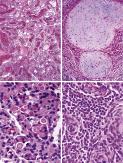
Metaplastic meningioma exhibits focal areas of metaplasia, which may differentiate along cartilaginous, osseous, or lipomatous lines. There is no prognostic significance ( Fig. 14-9 ).
Secretory meningioma has microscopic features similar to those of syncytial or transitional meningioma. In addition, individual tumor cells show discrete intracytoplasmic inclusion bodies that are strongly positive for carcinoembryonic antigen. Ultrastructurally, these inclusions are intracytoplasmic and represent deposits of dense fibrillogranular material surrounded by unit membrane with microvilli ( Fig. 14-9 ).
Lymphoplasmacyte rich meningioma is the least common, least well characterized, and most controversial meningioma subtype. Many examples previously reported in the literature are now recognized as reactive or inflammatory lesions, rather than meningiomas. Nevertheless, there are legitimate examples of meningiomas with prominent intratumoral lymphoplasmacytic infiltrates. The significance awaits further investigation ( Fig. 14-9 ).
Microcystic meningioma exhibits a distinctive architecture of spidery cell processes that form variously sized microcysts to the extent that, to the uninitiated, the tumor may not be recognized as a meningioma. Closer inspection will reveal typical bland nuclei. Microcystic meningioma often shows morphologic features that overlap with those of angiomatous meningioma (rich vasculature) and secretory meningioma (occasional pseudopsammoma bodies) ( Fig. 14-10 ). All three of these meningioma variants—angiomatous, secretory, and microcystic—frequently display “degenerative” nuclear atypia, and in some tumors the morphologic features are so overlapping that any of the three appellations might be applied. In the absence of high-grade features (such as elevated mitotic activity or brain invasion), all three are benign, WHO grade I, subtypes with no prognostic significance.
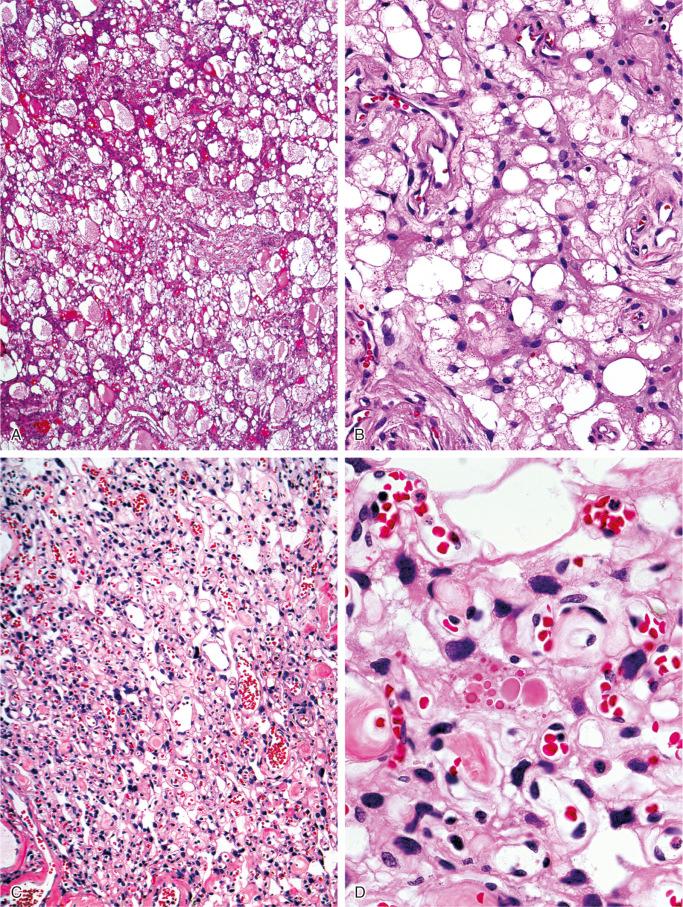
Chordoid meningioma is characterized by cords of meningothelial cells typically surrounded by a rich myxoid matrix ( Fig. 14-11 ).
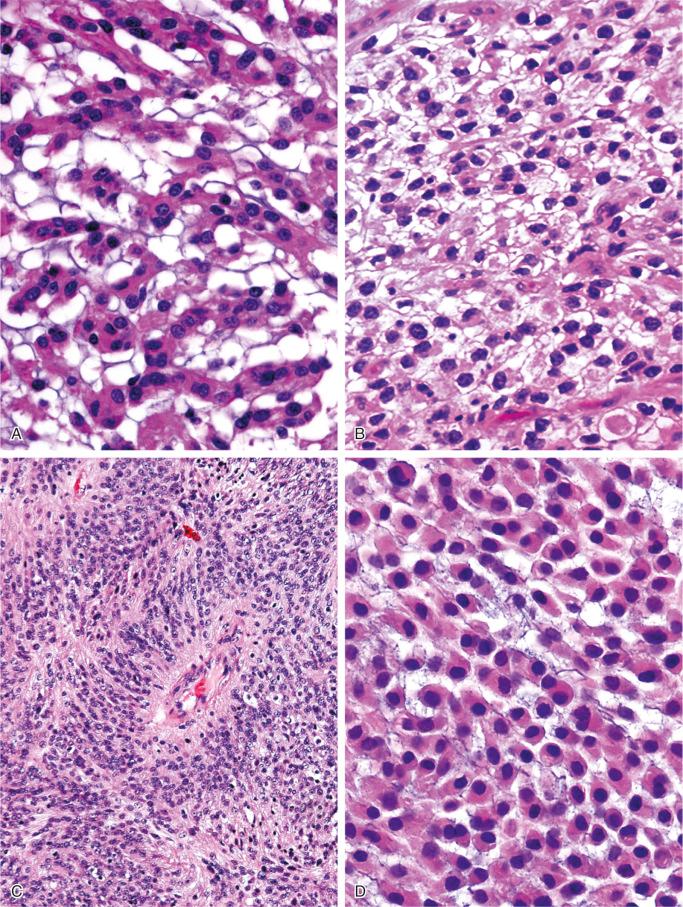
Clear cell meningioma is characterized by prominent cytoplasmic clearing ( Fig. 14-11 ).
Papillary meningioma represents a distinct variant of meningioma. Recognition of this entity has clinical significance because these neoplasms exhibit locally aggressive growth and are associated with late metastases. These neoplasms are composed of meningothelial cells arranged in papillary structures with central fibrovascular cores (perivascular pseudorosettes) ( Fig. 14-11 ).
Rhabdoid meningioma is another meningioma subtype with potential for aggressive clinical behavior. Tumor cells exhibit characteristic rhabdoid morphology, often lacking other typical architectural and cytologic features of meningioma.
Atypical and anaplastic meningiomas comprise the higher grade categories of meningiomas. Atypical meningiomas (WHO grade II) exhibit at least three of the following five histologic features: foci of micronecrosis, prominent nucleoli, sheeting architecture, small cell formation, or hypercellularity ( Figs. 14-12 ). Anaplastic meningioma (WHO grade III) exhibits morphologic features resembling sarcoma, carcinoma, or melanoma. These are among the rarest meningioma variants.
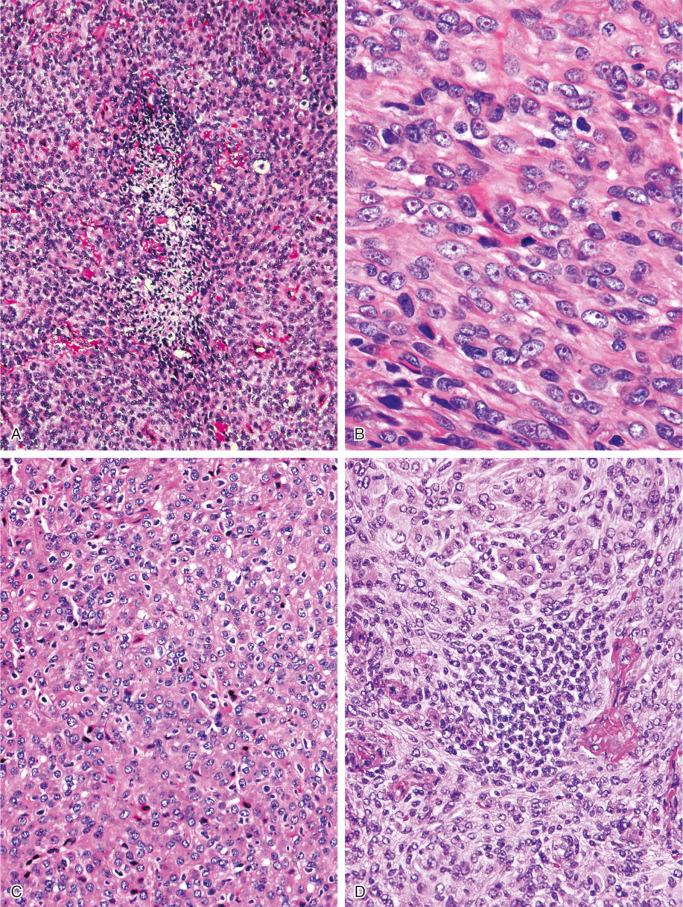
Brain invasive meningiomas exhibit increased potential for early recurrence and are therefore classified as WHO grade II. In cases in which it is uncertain whether the invaded tissue is brain parenchyma or reactive leptomeningeal tissue, immunostaining for GFAP or S-100 protein can be performed ( Fig. 14-13 ).
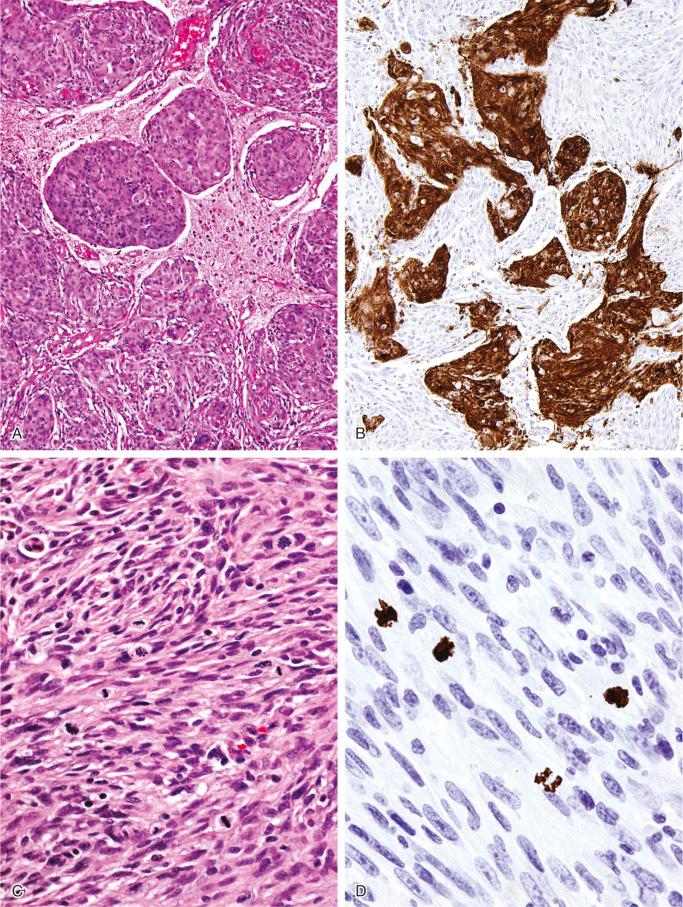
Grading of meningiomas is based on levels of mitotic activity ( Table 14-2 ). Upgrading of any meningioma histologic subtype is warranted when increased mitotic activity is present. Specifically, meningiomas with four or more mitoses per 10 contiguous high-power fields are classified as WHO grade II, and meningiomas with 20 or more mitoses per 10 contiguous high-power fields are classified as WHO grade III ( Fig. 14-13 ).
| WHO Grade I |
| Benign Meningioma |
| Histologic variant other than clear cell, chordoid, papillary, or rhabdoid Lacks criteria of grades II and III meningiomas |
| WHO Grade II |
| Atypical Meningioma |
| Mitotic index ≥4 per 10 high-power fields or At least 3 of 5 parameters:
or |
| Brain Invasion |
| or |
| Clear Cell Meningioma |
| or |
| Chordoid Meningioma |
| WHO Grade III |
| Anaplastic (Malignant) Meningioma |
| Mitotic index ≥20 per 10 high-power fields or Frank anaplasia (sarcoma, carcinoma, or melanoma-like histology) or |
| Papillary Meningioma |
| or |
| Rhabdoid Meningioma |
Meningiomas that invade osseous structures can provoke prominent reactive bone formation. Sometimes reactive new bone forms parallel striations. This orientation is best seen on specimen radiographs but can also be demonstrated during low power microscopic examination. Reactive bone formation may also take the form of haphazardly arranged bone trabeculae. Occasionally, the bone formation is so abundant that it overshadows underlying tumor cells.
Immunohistochemically, meningiomas are positive for epithelial membrane antigen. In the setting of cranial lesions, this feature is very helpful in distinguishing meningiomas from schwannomas and tumors of glial cell origin. As in all cells of mesenchymal origin, vimentin is strongly positive in meningiothelial cells. Approximately 20% of meningiomas show at least focal positivity for S-100 protein. Keratin is typically not present in meningioma, but it can be focally positive, especially in secretory meningioma.
The vast majority of meningiomas are clinically benign and their eradication depends on the size of the lesion, specific topographic involvement, as well as involvement of the vital structures of the central nervous system. A small proportion of meningiomas exhibit locally aggressive behavior. These tumors rarely may exhibit metastatic potential with involvement of extracranial osseous sites. Both grading of meningiomas and their molecular characteristics correlate to some degree with clinical behaviors. In general, grade I meningiomas behave as benign tumors, and grade II are locally aggressive, whereas grade III meningiomas have some degree of metastatic potential. Meningiomas characterized by mutations of the TRAF7, KLF4, and SMO genes are distinct and nearly always show a benign clinical course with chromosomal stability and have a tendency to originate in the medial skull base. Meningiomas containing the mutant NF2 gene frequently exhibit loss of chromosome 22, are genomically unstable, and are more likely atypical. These tumors have a tendency to originate over the cerebral and cerebellar convexities.
The solitary fibrous tumor, considered by most authors as a separate entity, is also designated as intracranial hemangiopericytoma. Although the meningothelial origin of these neoplasms is questionable, they have age-distribution and site-predilection patterns within the central nervous system that are similar to those of conventional meningiomas. The overall microscopic appearance of this neoplasm is identical to that of hemangiopericytoma (also see Chapter 13 ). Intracranial hemangiopericytoma has a high propensity for extracranial skeletal metastases. In fact, most bone hemangiopericytomas are metastatic lesions, and a significant proportion of them represent distant metastases from meningeal hemangiopericytoma. Extracranial skeletal metastases also occasionally occur in conventional (i.e., transitional) meningiomas with or without features of cytologic atypia. Historically, central nervous system hemangiopericytomas were lumped in with angiomatous meningiomas in a now discredited category of tumor termed angioblastic meningioma.
The radiologic features of solitary fibrous tumor of the central nervous system typically mimic those of meningioma; that is, they are dura-based circumscribed masses that show enhancement after contrast administration ( Fig. 14-14 ). At the more aggressive end of the spectrum, hemangiopericytoma (cellular solitary fibrous tumor) has a tendency for early recurrence and metastasis, including a high propensity for extracranial skeletal metastases.
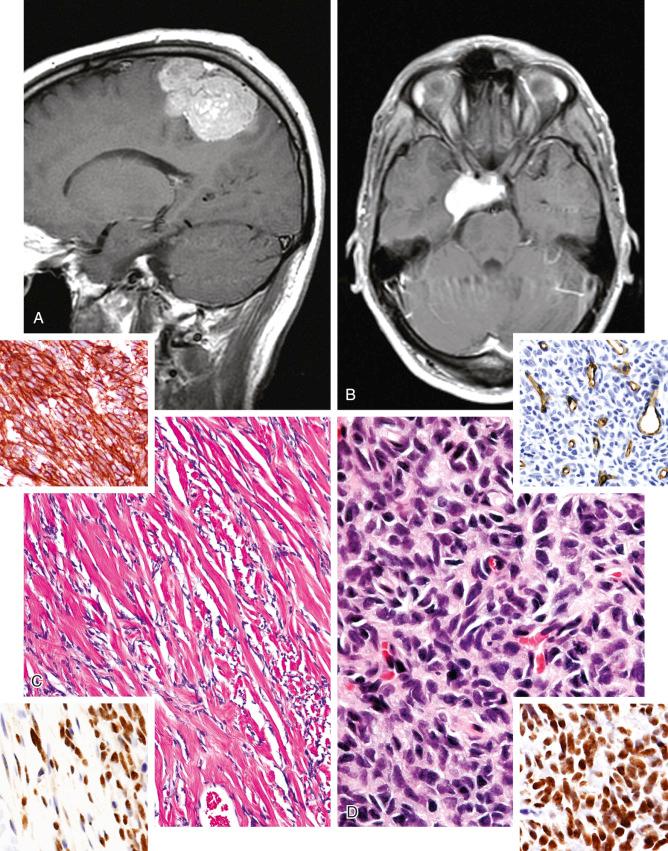
Grossly the lesions are usually well delineated, firm, and nodular, with an overall fibrous appearance. On cut section, the nodular nature of the lesion is evident and the great white fibrous mass may have foci of myxoid change or hemorrhage.
Solitary fibrous tumors are composed of spindle cells arranged in short ill-defined fascicles, described as a patternless pattern. A characteristic feature is the presence of striking hyalinization. The vasculature varies from narrow vascular channels to prominent open branching vessels referred to as hemangiopericytoma-like vasculature . The cellular variants of solitary fibrous tumors have overlapping features with soft tissue hemangiopericytoma. The solitary fibrous tumor family comprises a spectrum of tumors ranging from relatively indolent solitary fibrous tumor at one end to aggressive hemangiopericytoma (cellular solitary fibrous tumor) at the other ( Fig. 14-14 ). The microscopic features of solitary fibrous tumor in the central nervous system overlap with those of the more common ones that affect the soft tissue, predominantly the pleura. At the two ends of the spectrum, the tumors exhibit distinctive classical morphologic features, with solitary fibrous tumor displaying bland spindle cells separated by prominent bands of ropy collagen and strong diffuse immunoreactivity for CD34, whereas classical hemangiopericytoma is a highly vascular, densely cellular, mitotically active neoplasm in which CD34 reactivity is confined to the vasculature ( Fig. 14-13 ). However, it was recognized early on that many hemangiopericytomas display at least focal CD34 reactivity, and in fact the spectrum of solitary fibrous tumor embraces a wide range of transitional forms that blend in various proportions the morphologic, immunophenotypic and proliferative features of classical hemangiopericytoma and solitary fibrous tumor. Recognition of the kinship between solitary fibrous tumor and hemangiopericytoma was finally conclusively demonstrated beyond doubt by discovery of a shared underlying genetic signature.
Solitary fibrous tumors are characterized by the presence of a NAB2-STAT6 gene fusion in the vast majority of both soft tissue and central nervous system tumors ( Fig. 14-15 ). The fusion is caused by an inversion within chromosome 12 resulting in the juxtaposition of NAB2 and STAT6 neighbor genes. The breakpoint within STAT6 is conserved, and typically the fusion variants contain almost the entire STAT6 reading frame. There are shifting breakpoints within the NAB2 gene, but all of the variants retain the early growth response protein 1 binding domain (EBD). The transcriptional activation domain (TAD) of the STAT6 fusion partner is most likely responsible for the proliferation inducing activity of the chimeric NAB2-STAT6 protein. The nuclear localization of STAT6 protein driven by the NAB2 promoter in solitary fibrous tumors can be used as an auxiliary test in their differential diagnosis.
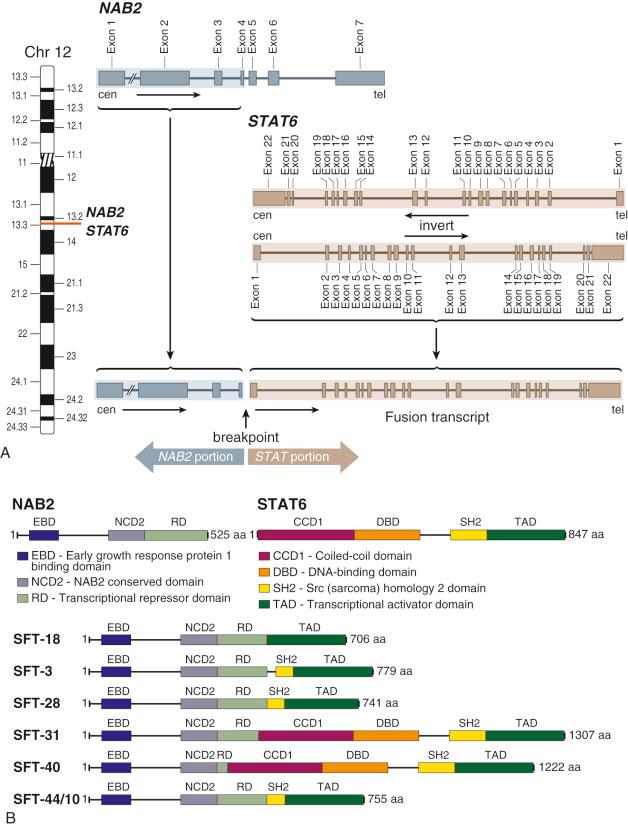
Myxopapillary ependymoma is a tumor that almost exclusively occurs in the region corresponding to the filum terminale and cauda equina. Microscopically, myxopapillary ependymoma resembles embryonal structures of this region. In fact, some myxopapillary ependymomas may originate from the so-called ependymal myxopapillary rests that occasionally are identified in the sacrococcygeal region. Similar to meningiomas, myxopapillary ependymomas can destroy bone and present with features suggesting a primary bone tumor ( Fig. 14-16 ). Rare examples of these lesions have been described in the presacral or postsacral soft tissue. Lesions located in extradural soft tissue are frequently associated with spina bifida, but myxopapillary ependymomas that occur in soft tissue have also been reported without any associated anatomic anomaly in the sacrolumbar region. They can present as lytic bone lesions that involve the lumbosacral region.
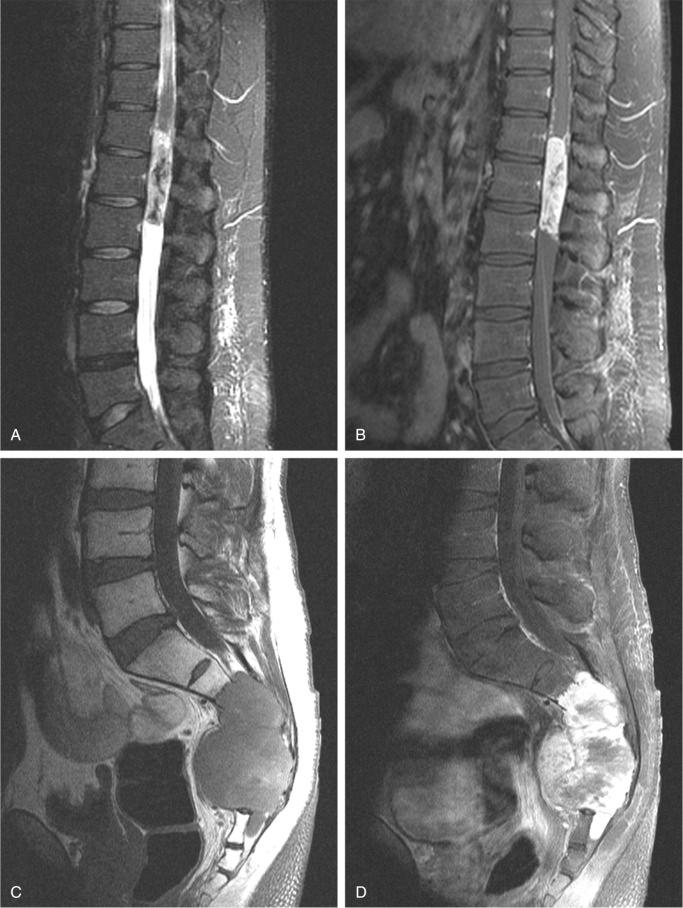
As the name implies, myxopapillary ependymoma is composed of ependymal cells arranged in papillary structures that show prominent stromal myxoid change. In general, the architecture of this variant of ependymoma mimics the normal embryonal structures of the filum terminale and cauda equina. The cells are arranged in a fernlike pattern around a central fibrovascular core ( Fig. 14-10 ). The cytoplasmic processes of neoplastic cells form radiating, rosette-like structures around vessels. The papillary architecture is accentuated by the collarlike arrangement of ependymal cells around the vessels. A mucoid substance is often present in the form of vesicular intercytoplasmic structures of varying sizes that separate tumor cells ( Fig. 14-17 ). Distinctive, peculiar structures seen in myxopapillary ependymoma are eosinophilic globoid bodies positive for periodic acid-Schiff, alcian blue, Masson, and reticulin stains. Ultrastructurally, they are composed of a collagen-rich substance surrounded by tumor cell processes resting on basal lamina. A hallmark of all ependymomas, including the myxopapillary variant, is their microscopically recognizable dualistic phenotype (i.e., glial and epithelial). However, immunohistochemical coexpression of epithelial and glial markers such as glial fibrillary acidic proteins, epithelial membrane antigen, and keratin is variable. Most ependymomas are positive for glial fibrillary acidic protein and often are focally positive for epithelial membrane antigen.
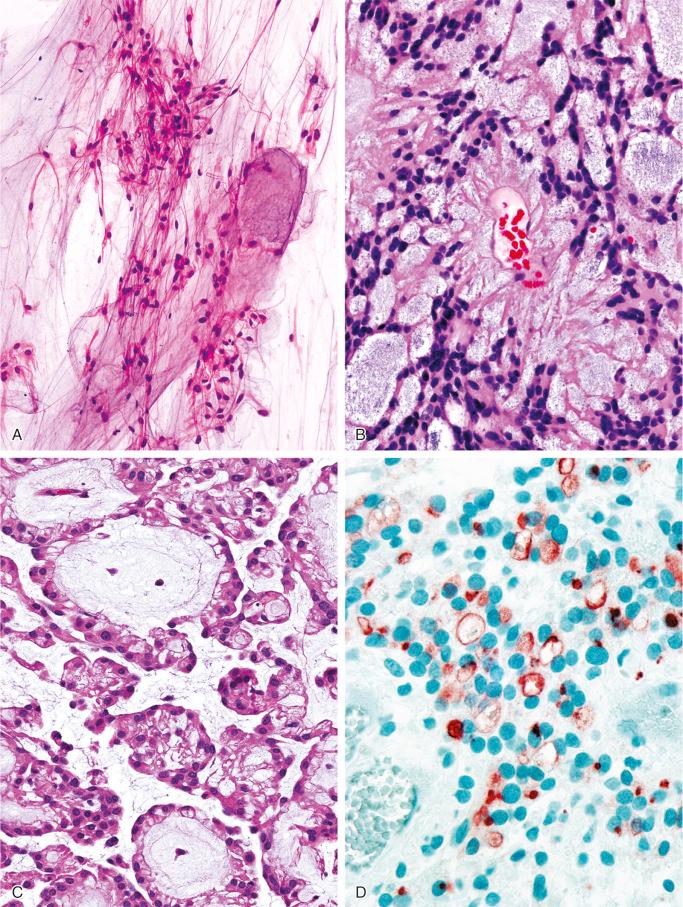
Myxopapillary ependymomas are slow-growing tumors with a tendency for local recurrence. Lesions that are completely excised are associated with an approximately 20-year mean survival rate. Typically, myxopapillary ependymoma exhibits slow, local destructive growth. Eventually the lesion disrupts the bone and extends to the perisacral tissue. Recurrences are typically multiple nodules that may coalesce. Local dissemination with multiple metastatic or satellite nodules is frequently seen in terminal stages of the disease. Long-term lesions may grow to a considerable size and compress pelvic and abdominal organs.
Intraosseous schwannoma (neurilemmoma) is extremely rare. We have seen only a few examples of this lesion in bone, and fewer than 200 examples have been described in the literature. Intraosseous schwannoma is similar to more common soft tissue schwannomas. It accounts for less than 0.2% of all primary bone tumors.
Schwannoma can involve bone by three mechanisms: (1) secondary erosion by an extraosseous tumor; (2) tumor arising from a nerve coursing through a canal in a bone and causing erosion of the bone, creating a dumbbell-shaped configuration; or (3) tumor arising centrally (intramedullary) in a bone. The first two mechanisms occur most frequently. A true intramedullary origin is exceptional.
Schwannoma (neurilemmoma) is a benign peripheral nerve sheath tumor composed of Schwann cells that are frequently arranged in hypercellular and hypocellular areas, referred to as Antoni A and B tissue, respectively . Schwannomas are encapsulated and typically arise from a recognizable nerve trunk.
Intraosseous schwannomas arise most frequently in the mandible and sacrum. They have also been reported in a number of other locations, including the vertebral bodies, ulna, humerus, femur, tibia, patella, scapula, rib, maxilla, and small bones of the hands. Intraosseous schwannomas were also described in a setting of neurofibromatosis type 3 (schawannomatosis).
The most common symptoms are pain and localized swelling over the affected area.
Radiographically, the lesions are lytic, but a narrow sclerotic zone may be present at the periphery ( Fig. 14-18 ). The bone contour may be expanded with no periosteal reaction. The cortex may be thinned, but no true cortical destruction or extension into soft tissue is present. Although the lesions are primarily lytic, they may have incomplete internal trabeculation or lobulation ( Fig. 14-18 ). The radiographic appearance is usually interpreted as benign, but a specific diagnosis cannot be made from radiographic findings alone. It is difficult to differentiate intraosseous schwannoma on radiographs from other conditions that have similar radiographic features, such as solitary bone cyst, chondroblastoma, chondromyxoid fibroma, and giant cell tumor. CT scans show sharp delineation of the tumor and may disclose the dumbbell nature of the lesion ( Figs. 14-19 and 14-20 ). On MRI, schwannomas appear as uniformly contrast enhancing well-delineated lesions with an anatomic relationship to the adjacent nerve structures ( Figs.14-19 and 14-20 ).
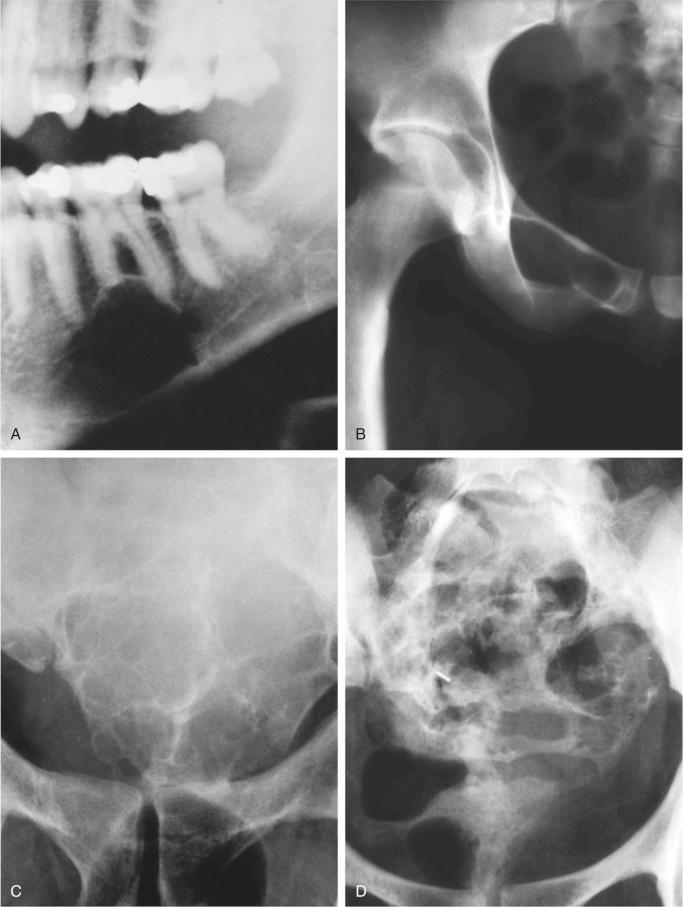
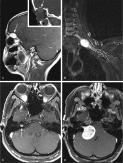
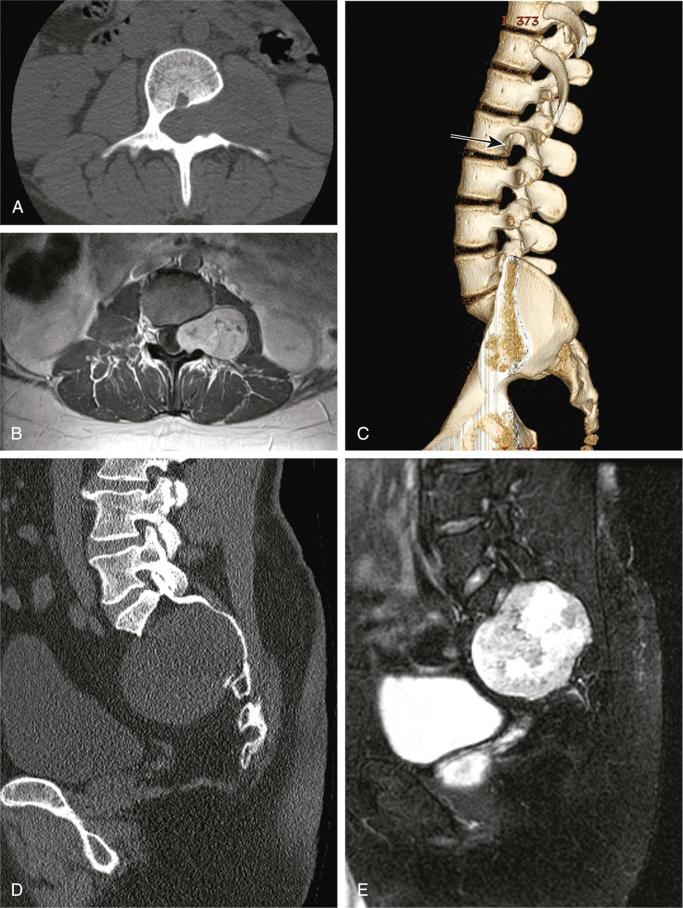
Become a Clinical Tree membership for Full access and enjoy Unlimited articles
If you are a member. Log in here